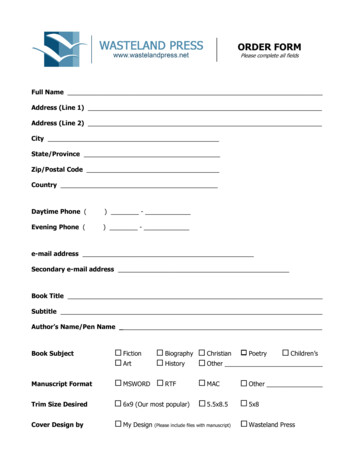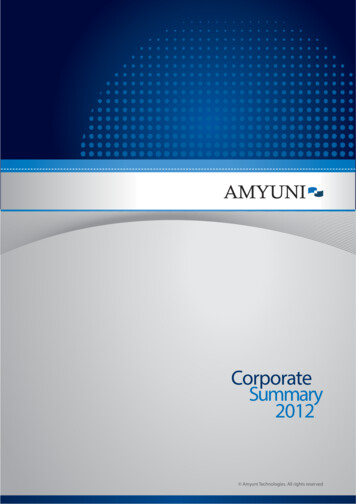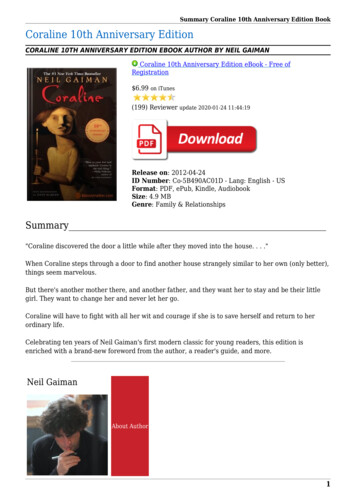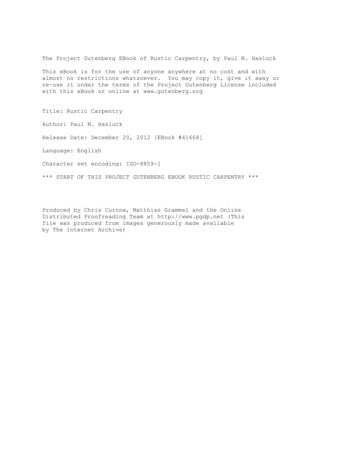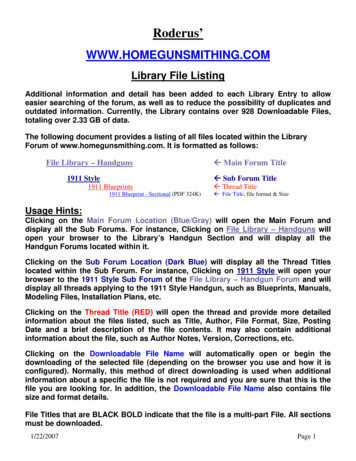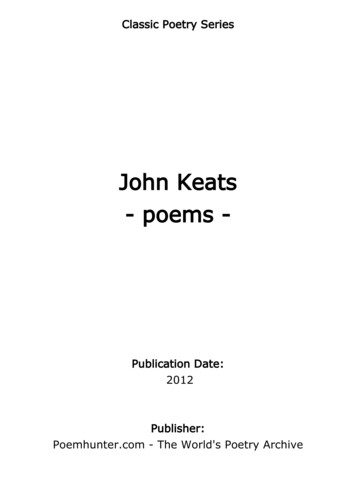
Transcription
Classic Poetry SeriesJohn Keats- poems -Publication Date:2012Publisher:Poemhunter.com - The World's Poetry Archive
John Keats(31 October 1795 – 23 February 1821)John Keats was an English Romantic poet. He was one of the main figures of thesecond generation of romantic poets along with ahref n/" LordByron /a and a href "http://www.poemhunter.com/percy-byssheshelley/" Percy Bysshe Shelley /a , despite his work only having been inpublication for four years before his death.Although his poems were not generally well received by critics during his life, hisreputation grew after his death, so that by the end of the 19th century he hadbecome one of the most beloved of all English poets. He had a significantinfluence on a diverse range of later poets and writers. Jorge Luis Borges statedthat his first encounter with Keats was the most significant literary experience ofhis life.The poetry of Keats is characterized by sensual imagery, most notably in theseries of odes. Today his poems and letters are some of the most popular andmost analyzed in English literature. b Biography /b b Early Life /b John Keats was born on 31 October 1795 to Thomas and Frances Jennings Keats.Keats and his family seemed to have marked his birthday on 29 October,however baptism records give the birth date as the 31st. He was the eldest offour surviving children; George (1797–1841), Thomas (1799–1818) and FrancesMary "Fanny" (1803–1889). Another son was lost in infancy. John was born incentral London although there is no clear evidence of the exact location. Hisfather first worked as a hostler at the stables attached to the Swan and Hoop inn,an establishment he later managed and where the growing family lived for someyears. Keats believed that he was born at the inn, a birthplace of humble origins,but there is no evidence to support this. The Keats at the Globe pub nowoccupies the site, a few yards from modern day Moorgate station. He wasbaptised at St Botolph-without-Bishopsgate and sent to a local dame school as achild.His parents were unable to afford Eton or Harrow, so in the summer of 1803 hewas sent to board at John Clarke's school in Enfield, close to his grandparents'house. The small school had a liberal, progressive outlook and a progressivewww.PoemHunter.com - The World's Poetry Archive1
curriculum more modern than the larger, more prestigious schools. In the familyatmosphere at Clarke's, Keats developed an interest in classics and history whichwould stay with him throughout his short life. The headmaster's son, CharlesCowden Clarke, would become an important influence, mentor and friend,introducing Keats to Renaissance literature including Tasso, Spenser andChapman's translations. Keats is described as a volatile character "always inextremes", given to indolence and fighting. However at 13 he began focusing hisenergy towards reading and study, winning his first academic prize inmidsummer 1809.In April 1804, when Keats was eight, his father died after fracturing his skullfalling from his horse when returning from visiting John and his brother Georgeat the school. Thomas died intestate. Frances remarried two months later, butleft her new husband soon afterwards, and the four children went to live withtheir grandmother, Alice Jennings, in the village of Edmonton. In March 1810,when Keats was 14, his mother died of tuberculosis leaving the children in thecustody of their grandmother. She appointed two guardians, Richard Abbey andJohn Sandell, to take care of them. That autumn, Keats left Clarke's school toapprentice with Thomas Hammond, a surgeon and apothecary, neighbour anddoctor of the Jennings family, and lodged in the attic above the surgery at 7Church Street until 1813. Cowden Clarke, who remained a close friend of Keats,described this as "the most placid time in Keats's life". b Early Career /b From 1814 Keats had two bequests held in trust for him until his 21st birthday: 800 willed by his grandfather John Jennings (about 34,000 in today's money)and a portion of his mother's legacy, 8000 (about 340,000 today), to beequally divided between her living children. It seems he was not told of either,since he never applied for any of the money. Historically, blame has often beenlaid on Abbey as legal guardian, but he may well have also been unaware.William Walton, solicitor for Keats's mother and grandmother, definitely did knowand had a duty of care to relay the information to Keats. It seems he did not.The money would have made a critical difference to the poet's expectations.Money was always a great concern and difficulty for him, as he struggled to stayout of debt and make his way in the world independently.On First Looking into Chapman's Homer i Much have I travell'd in the realms of gold,And many goodly states and kingdoms seen;Round many western islands have I beenWhich bards in fealty to Apollo hold.www.PoemHunter.com - The World's Poetry Archive2
Oft of one wide expanse had I been toldThat deep-browed Homer ruled as his demesne;Yet did I never breathe its pure sereneTill I heard Chapman speak out loud and bold:Then felt I like some watcher of the skiesWhen a new planet swims into his ken;Or like stout Cortez when with eagle eyesHe star'd at the Pacific — and all his menLook'd at each other with a wild surmise —Silent, upon a peak in Darien. /i “”The sonnet "On First Looking into Chapman's Homer"October 1816Having finished his apprenticeship with Hammond, Keats registered as a medicalstudent at Guy's Hospital (now part of King's College London) and began there inOctober 1815. Within a month of starting, he was accepted as a dresser at thehospital, assisting surgeons during operations, the equivalent of a junior housesurgeon today. It was a significant promotion marking a distinct aptitude formedicine, the position bringing increased responsibility and workload. His longand expensive medical training with Hammond and at Guy's Hospital led hisfamily to assume this would be his lifelong career, assuring financial security, andit seems that at this point Keats had a genuine desire to become a doctor. Keatslodged near the hospital at 28 St Thomas's Street in Southwark, with othermedical students.Keats's training took up increasing amounts of his writing time and he feltincreasingly ambivalent about his medical career. He felt presented with a starkchoice. Keats's first surviving poem, An Imitation of Spenser, had been written in1814, when Keats was 19. Now, strongly drawn by ambition, inspired by fellowpoets such as Leigh Hunt and Byron, and beleaguered by family financial crises,he suffered periods of depression. His brother George wrote that John "fearedthat he should never be a poet, & if he was not he would destroy himself". In1816, Keats received his apothecary's licence which made him eligible to practiseas an apothecary, physician and surgeon, but before the end of the year heannounced to his guardian that he had resolved to be a poet, not a surgeon.Though he continued his work and training at Guy's, Keats was devotingincreasing time to the study of literature, experimenting with verse forms,particularly at this time sonnets. In May 1816, Leigh Hunt agreed to publish thesonnet O Solitude in his magazine The Examiner, a leading liberal magazine ofwww.PoemHunter.com - The World's Poetry Archive3
the day. It is the first appearance of Keats's poems in print and Charles CowdenClarke refers to it as his friend's red letter day, first proof that Keats's ambitionswere valid. In the summer of that year he went with Clarke to the seaside townof Margate to write. There he began Calidore and initiated the era of his greatletter writing. On his return to London he took lodgings at 8 Dean Street,Southwark and braced himself for further study in order to become a member ofthe Royal College of Surgeons.In October, Clarke introduced Keats to the influential Hunt, a close friend ofByron and Shelley. Five months later Poems, the first volume of Keats verse, waspublished, which included "I stood tiptoe" and "Sleep and Poetry", both poemsstrongly influenced by Hunt. It was a critical failure, arousing little interest,although Reynolds reviewed it favourably in The Champion. Clarke commentedthat the book "might have emerged in Timbuctoo". Keats's publishers, Charlesand James Ollier, felt ashamed of the book. Keats immediately changedpublishers to Taylor and Hessey on Fleet Street. Unlike Olliers, Keats's newpublishers were enthusiastic about his work. Within a month of the publication ofPoems they were planning a new Keats volume and had paid him an advance.Hessey became a steady friend to Keats and made the company's roomsavailable for young writers to meet. Their publishing lists would come to includeColeridge, Hazlitt, Clare, Hogg, Carlyle and Lamb.At Taylor and Hessey Keats met their Eton-educated lawyer Richard Woodhouse.Woodhouse, who advised the publishers on literary as well as legal matters, wasdeeply impressed by Poems. Though he noted that Keats could be "wayward,trembling, easily daunted", Woodhouse was convinced of Keats's genius, a poetto support as he became one of England's greatest writers. Soon after they met,the two became close friends and Woodhouse started to collect Keatsiana,documenting as much as he could about Keats's poetry, an archive that survivesas one of the main sources of information on Keats's n casts him as Boswell toKeats' Johnson, ceaselessly promoting the writer's work, fighting his corner,spurring his poetry on to greater heights. At the end, Woodhouse would be oneof the few people to accompany Keats to Gravesend to embark on his final trip toRome.In spite of the bad reviews of Poems, Hunt published the essay Three YoungPoets (Shelley, Keats and Reynolds) and the sonnet On First Looking intoChapman's Homer, foreseeing great things to come. He introduced Keats tomany prominent men in his circle, including editor of The Times Thomas Barnes,writer Charles Lamb, conductor Vincent Novello and poet John HamiltonReynolds, who would become a close friend. He was also meeting William Hazlittregularly, a powerful literary figure of the day. It was a decisive turning point forwww.PoemHunter.com - The World's Poetry Archive4
Keats, establishing him in the public eye as a figure in, what Hunt termed 'a newschool of poetry'. At this time Keats wrote to his friend Bailey: "I am certain ofnothing but the holiness of the Heart's affections and the truth of theimagination. What imagination seizes as Beauty must be truth". This wouldeventually transmute into the concluding lines of Ode on a Grecian Urn: "'Beautyis truth, truth beauty' – that is all / you know on earth, and all ye need to know".In early December, under the heady influence of his artistic friends, Keats toldAbbey that he had decided to give up medicine in favour of poetry, to Abbey'sfury. Keats had spent a great deal on his medical training and had made severallarge loans that he could ill afford.Having left his training at the hospital, suffering from a succession of colds, andunhappy with living in damp rooms in London, Keats moved with his brothersinto rooms at 1 Well Walk in the village of Hampstead in April 1817. Both Johnand George nursed their brother Tom, who was suffering from tuberculosis. Thehouse was close to Hunt and others from his circle in Hampstead, as well as toColeridge, respected elder of the first wave of Romantic poets, Around this timehe was introduced to Charles Wentworth Dilke, James Rice and Benjamin Bailey.In June 1818, Keats began a walking tour of Scotland, Ireland and the LakeDistrict with his friend Charles Armitage Brown. Keats' brother George and hiswife Georgina accompanied them as far as Lancaster and then continued toLiverpool, from where the couple would emigrate to America. They lived in Ohioand Louisville, Kentucky until 1841 when George's investments failed. Like Keats'other brother, they died penniless and racked by tuberculosis. There would be noeffective treatment for the disease until 1921. In July, while on the Isle of Mull,Keats caught a bad cold and "was too thin and fevered to proceed on thejourney". After his return south in August, Keats continued to nurse Tom,exposing himself to infection. Some biographers suggest that this is whentuberculosis, his "family disease", first took hold. Tom Keats died on 1 December1818. b Wentworth Place /b John Keats moved to the newly built Wentworth Place, owned by his friendCharles Armitage Brown. It was also on the edge of Hampstead Heath, tenminutes walk south of his old home in Well Walk. The winter of 1818–19, thougha difficult period for the poet, marked the beginning of his annus mirabilis inwhich he wrote his most mature work. He had been inspired by a series of recentlectures by Hazlitt on English poets and poetic identity and had also met ahref "http://www.poemhunter.com/william-wordsworth/" Wordsworth /a .Keats may have seemed to his friends to be living on comfortable means, but inwww.PoemHunter.com - The World's Poetry Archive5
reality he was borrowing regularly from Abbey and his friends.He composed five of his six great odes at Wentworth Place in April and May and,although it is debated in which order they were written, "Ode to Psyche" openedthe published series. According to Brown, "Ode to a Nightingale" was composedunder a plum tree in the garden. Brown wrote, "In the spring of 1819 anightingale had built her nest near my house. Keats felt a tranquil and continualjoy in her song; and one morning he took his chair from the breakfast-table tothe grass-plot under a plum-tree, where he sat for two or three hours. When hecame into the house, I perceived he had some scraps of paper in his hand, andthese he was quietly thrusting behind the books. On inquiry, I found thosescraps, four or five in number, contained his poetic feelings on the song of ournightingale." Dilke, co-owner of the house, strenuously denied the story, printedin Milnes' 1848 biography of Keats, dismissing it as pure delusion. i My heart aches, and a drowsy numbness painsMy sense, as though of hemlock I had drunk,Or emptied some dull opiate to the drainsOne minute past, and Lethe-wards had sunk:’Tis not through envy of thy happy lot,But being too happy in thine happiness,—That thou, light-winged Dryad of the trees,In some melodious plotOf beechen green, and shadows numberless,Singest of summer in full-throated ease. /i “”First stanza of "Ode to a Nightingale",May 1819"Ode on a Grecian Urn" and "Ode on Melancholy" were inspired by sonnet formsand probably written after "Ode to a Nightingale". Keats's new and progressivepublishers Taylor and Hessey issued Endymion, which Keats dedicated to ThomasChatterton, a work that he termed "a trial of my Powers of Imagination". It wasdamned by the critics, giving rise to Byron's quip that Keats was ultimately"snuffed out by an article", suggesting that he never truly got over it. Aparticularly harsh review by John Wilson Croker appeared in the April 1818edition of The Quarterly Review. " John Gibson Lockhart writing in Blackwood'sMagazine, described Endymion as "imperturbable drivelling idiocy". With bitingsarcasm, Lockhart advised, "It is a better and a wiser thing to be a starvedapothecary than a starved poet; so back to the shop Mr John, back to plasters,pills, and ointment boxes ". It was Lockhart at Blackwoods who coined thewww.PoemHunter.com - The World's Poetry Archive6
defamatory term "the Cockney School" for Hunt and his circle, which includedboth Hazlitt and Keats. The dismissal was as much political as literary, aimed atupstart young writers deemed uncouth for their lack of education, non-formalrhyming and "low diction". They had not attended Eton, Harrow or Oxbridge andthey were not from the upper classes.In 1819, Keats wrote The Eve of St. Agnes, "La Belle Dame sans Merci",Hyperion, Lamia and Otho (critically damned and not dramatised until 1950). Thepoems "Fancy" and "Bards of passion and of mirth" were inspired by the gardenof Wentworth Place. In September, very short of money and in despairconsidering taking up journalism or a post as a ship's surgeon, he approached hispublishers with a new book of were unimpressed with the collection, finding thepresented versions of "Lamia" confusing, and describing "St Agnes" as having a"sense of pettish disgust" and "a 'Don Juan' style of mingling up sentiment andsneering" concluding it was "a poem unfit for ladies". The final volume Keatslived to see, Lamia, Isabella, The Eve of St. Agnes, and Other Poems, waseventually published in July 1820. It received greater acclaim than had Endymionor Poems, finding favourable notices in both The Examiner and EdinburghReview. It would come to be recognised as one of the most important poeticworks ever published.Wentworth Place now houses the Keats House museum. b Isabella Jones and Fanny Brawne /b Keats befriended Isabella Jones in May 1817, while on holiday in the village of BoPeep, near Hastings. She is described as beautiful, talented and widely read, notof the top flight of society yet financially secure, an enigmatic figure who wouldbecome a part of Keats's ghout their friendship Keats never hesitates to own hissexual attraction to her, although they seem to enjoy circling each other ratherthan offering commitment. He writes that he "frequented her rooms" in thewinter of 1818–19, and in his letters to George says that he "warmed with her"and "kissed her". It is unclear how close they were, but Bate and Gittingssuggest the trysts may represent a sexual initiation for Keats. Jones' greatestsignificance may be as an inspiration and steward of Keats's writing. The themesof The Eve of St. Agnes and The Eve of St Mark may well have been suggestedby her, the lyric Hush, Hush! ["o sweet Isabel"] was about her, and that the firstversion of "Bright Star" may have originally been for her. In 1821, Jones was oneof the first in England to be notified of Keats's death.Letters and drafts of poems suggest that Keats first met Frances (Fanny) Brawnebetween September and November 1818. It is likely that the 18-year-old Brawnewww.PoemHunter.com - The World's Poetry Archive7
visited the Dilke family at Wentworth Place before she lived there. She was bornin the hamlet of West End (now in the district of West Hampstead), on 9 August1800. Like Keats's grandfather, her grandfather kept a London inn, and both lostseveral family members to tuberculosis. She shared her first name with bothKeats's sister and mother, and had a talent for dress-making and languages aswell as a natural theatrical bent. During November 1818 she developed anintimacy with Keats, but it was shadowed by the illness of Tom Keats, whomJohn was nursing through this period.On 3 April 1819, Brawne and her widowed mother moved into the other half ofDilke's Wentworth Place, and Keats and Brawne were able to see each otherevery day. Keats began to lend Brawne books, such as Dante's Inferno, and theywould read together. He gave her the love sonnet "Bright Star" (perhaps revisedfor her) as a declaration. It was a work in progress which he continued at untilthe last months of his life, and the poem came to be associated with theirrelationship. "All his desires were concentrated on Fanny". From this point thereis no further documented mention of Isabella Jones. Sometime before the end ofJune, he arrived at some sort of understanding with Brawne, far from a formalengagement as he still had too little to offer, with no prospects and financialstricture. Keats endured great conflict knowing his expectations as a strugglingpoet in increasingly hard straits would preclude marriage to Brawne. Their loveremained unconsummated; jealousy for his 'star' began to gnaw at him.Darkness, disease and depression surrounded him, reflected in poems such asThe Eve of St. Agnes and "La Belle Dame sans Merci" where love and death bothstalk. "I have two luxuries to brood over in my walks;" he wrote to her, ".yourloveliness, and the hour of my death".In one of his many hundreds of notes and letters, Keats wrote to Brawne on 13October 1819: "My love has made me selfish. I cannot exist without you – I amforgetful of every thing but seeing you again – my Life seems to stop there – Isee no further. You have absorb'd me. I have a sensation at the present momentas though I was dissolving – I should be exquisitely miserable without the hopeof soon seeing you . I have been astonished that Men could die Martyrs forreligion – I have shudder'd at it – I shudder no more – I could be martyr'd for myReligion – Love is my religion – I could die for that – I could die for you."Tuberculosis took hold and he was advised by his doctors to move to a warmerclimate. In September 1820 Keats left for Rome knowing he would probablynever see Brawne again. After leaving he felt unable to write to her or read herletters, although he did correspond with her mother. He died there five monthslater. None of Brawne's letters to Keats survive; he requested that her letters bedestroyed after his death.www.PoemHunter.com - The World's Poetry Archive8
It took a month for the news of his death to reach London, after which Brawnestayed in mourning for six years. In 1833, more than 12 years after his death,she married and went on to have three children; she outlived Keats by more than40 years. The 2009 film Bright Star, written and directed by Jane Campion,focuses on Keats' relationship with Fanny Brawne. b Last months: Rome /b During 1820 Keats displayed increasingly serious symptoms of tuberculosis,suffering two lung haemorrhages in the first few days of February. He lost largeamounts of blood and was bled further by the attending physician. Hunt nursedhim in London for much of the following summer. At the suggestion of hisdoctors, he agreed to move to Italy with his friend Joseph Severn. On 13September, they left for Gravesend and four days later boarded the sailing brig"Maria Crowther", where he made the final revisions of "Bright Star". The journeywas a minor catastrophe: storms broke out followed by a dead calm that slowedthe ship’s progress. When they finally docked in Naples, the ship was held inquarantine for ten days due to a suspected outbreak of cholera in Britain. Keatsreached Rome on November 14, by which time any hope of the warmer climatehe sought had disappeared.Keats wrote his last letter on November 30, 1820 to Charles Armitage Brown;"Tis the most difficult thing in the world to me to write a letter. My stomachcontinues so bad, that I feel it worse on opening any book – yet I am muchbetter than I was in Quarantine. Then I am afraid to encounter the proing andconning of any thing interesting to me in England. I have an habitual feeling ofmy real life having past, and that I am leading a posthumous existence".He moved into a villa on the Spanish Steps, today the Keats-Shelley MemorialHouse museum. Despite care from Severn and Dr. James Clark, his healthrapidly deteriorated, and the medical attention he received may have hastenedhis death. In November 1820, Clark declared that the source of his illness was"mental exertion" and the source was largely situated in his stomach. Clarkeventually diagnosed consumption (tuberculosis) and placed Keats on astarvation diet of an anchovy and a piece of bread a day, hoping to reduce theblood flow to his stomach. He bled the poet; a standard treatment of the day,but probably contributing significantly to Keats's weakness. Keats's friend Brownwrites: "They could have used opium in small doses, and Keats had asked Severnto buy a bottle of opium when they were setting off on their voyage. WhatSevern didn't realise was that Keats saw it as a possible resource if he wanted tocommit suicide. He tried to get the bottle from Severn on the voyage but Severnwww.PoemHunter.com - The World's Poetry Archive9
wouldn't let him have it. Then in Rome he tried again . Severn was in such aquandary he didn't know what to do, so in the end he went to the doctor whotook it away. As a result Keats went through dreadful agonies with nothing toease the pain at all."On 10 December, Severn returned from an early walk and woke Keats.Immediately, the poet began to cough and then vomit blood, about two cupfuls.Clark was summoned and promptly bled him. The loss of blood dizzied andconfused Keats. When Clark left, Keats got out of his bed, stumbled around therooms, and said to Severn, "This day shall be my last." Severn feared a suicideattempt and hid any sharp object he could find as well as the laudanumprescribed by Clarke. Keats was delirious for the rest of the day, until a violenthaemorrhage and bleeding weakened him into calm. Over the next nine days hesuffered five severe haemorrhages and continued bleedings by Clark. The doctorvisited constantly and put him on a strict diet, mostly fish. Keats begged forfood, believing he was being starved. Clark held no hope of recovery andadmitted as much to Keats. The poet's thoughts turned again to suicide and hebegged Severn for the laudanum, at first appealing to Severn's self-interest, buthe was refused. Keats became angry; he raged at Severn for keeping him aliveagainst his will. When Severn, not trusting himself, gave the bottle to Clark,Keats turned on the doctor asking "How long is this posthumous life of mine tolast?" b Death /b The first months of 1821 marked a slow and steady decline into the final stage oftuberculosis. Keats was coughing up blood and covered in sweat. Severn nursedhim devotedly and observed in a letter how Keats would sometimes cry uponwaking to find himself still alive. Severn writes,"Keats raves till I am in a complete tremble for him.about four, the approachesof death came on. [Keats said] 'Severn—I—lift me up—I am dying—I shall dieeasy; don't be frightened—be firm, and thank God it has come.' I lifted him up inmy arms. The phlegm seem'd boiling in his throat, and increased until eleven,when he gradually sank into death, so quiet, that I still thought he slept."John Keats died on 23 February 1821 and was buried in the Protestant Cemetery,Rome. His last request was to be placed under an unnamed tombstone whichcontained only the words (in pentameter), "Here lies one whose name was writ inwater." Severn and Brown erected the stone, which under a relief of a lyre withbroken strings, contains the epitaph:www.PoemHunter.com - The World's Poetry Archive10
"This Grave / contains all that was Mortal / of a / Young English Poet / Who / onhis Death Bed, in the Bitterness of his Heart / at the Malicious Power of hisEnemies / Desired / these Words to be / engraven on his Tomb Stone: / Here liesOne / Whose Name was writ in Water. 24 February 1821"There is a discrepancy of one day between the official date of death and that onthe gravestone. Severn and Brown added their lines to the stone in protest at thecritical reception of Keats's work. Hunt blamed his death on the QuarterlyReview's scathing attack of "Endymion". As Byron quipped in his narrative poemDon Juan;'Tis strange the mind, that very fiery particleShould let itself be snuffed out by an article.(canto 2, stanza 60)Seven weeks after the funeral Shelley memorialised Keats in his poem Adonaïs.Clark saw to the planting of daisies on the grave, saying that Keats would havewished it. For public health reasons, the Italian health authorities burned thefurniture in Keats's room, scraped the walls, made new windows, doors andflooring. The ashes of Shelley, one of Keats’s most fervent champions, are buriedin the cemetery and Joseph Severn is buried next to Keats. Describing the sitetoday, Marsh wrote, "In the old part of the graveyard, barely a field when Keatswas buried here, there are now umbrella pines, myrtle shrubs, roses, and carpetsof wild violets". b Reception /b When Keats died at 25, he had been writing poetry seriously for only about sixyears, from 1814 until the summer of 1820; and publishing for only four. In hislifetime, sales of Keats's three volumes of poetry probably amounted to only 200copies. His first poem, the sonnet O Solitude appeared in the Examiner in May1816, while his collection Lamia, Isabella, The Eve of St. Agnes and other poemswas published in July 1820 before his last visit to Rome. The compression of hispoetic apprenticeship and maturity into so short a time is just one remarkableaspect of Keats's work.Although prolific during his short career, and now one of the most studied andadmired British poets, his reputation rests on a small body of work, centred onthe Odes, and only in the creative outpouring of the last years of his short lifewas he able to express the inner intensity for which he has been lauded since hisdeath. Keats was convinced that he had made no mark in his lifetime. Aware thathe was dying, he wrote to Fanny Brawne in February 1820, "I have left nowww.PoemHunter.com - The World's Poetry Archive11
immortal work behind me – nothing to make my friends proud of my memory –but I have lov'd the principle of beauty in all things, and if I had had time I wouldhave made myself remember'd."Keats's ability and talent was acknowledged by several influential contemporaryallies such as Shelley and a href "http://www.poemhunter.com/james-henryleigh-hunt/" Hunt /a . His admirers praised him for thinking "on his pulses",for having developed a style which was more heavily loaded with sensualities,more gorgeous in its effects, more voluptuously alive than any poet who hadcome before him: 'loading every rift with ore'. Shelley often corresponded withKeats in Rome, and loudly declared that Keats's death had been brought on bybad reviews in the Quarterly Review. Seven weeks after the funeral he wroteAdonaïs, a despairing elegy, stating that Keats' early death was a personal andpublic tragedy: i The loveliest and the last,The bloom, whose petals nipped before they blewDied on the promise of the fruit. /i Although Keats
John Keats was an English Romantic poet. He was one of the main figures of the second generation of romantic poets along with a . that the book "might have emerged in Timbuctoo". Keats's pu






